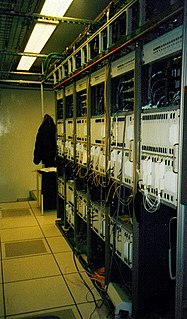See also
![]() This article incorporates public domain material from the General Services Administration document: "Federal Standard 1037C".(in support of MIL-STD-188)
This article incorporates public domain material from the General Services Administration document: "Federal Standard 1037C".(in support of MIL-STD-188)
In telecommunication, the term long-haul communications has the following meanings:
1. In public switched networks, pertaining to circuits that span large distances, such as the circuits in inter-LATA, interstate, and international communications. See also Long line (telecommunications)
2. In the military community, communications among users on a national or worldwide basis.
Note 1: Compared to tactical communications, long-haul communications are characterized by (a) higher levels of users, such as the US National Command Authority, (b) more stringent performance requirements, such as higher quality circuits, (c) longer distances between users, including worldwide distances, (d) higher traffic volumes and densities, (e) larger switches and trunk cross sections, and (f) fixed and recoverable assets.
Note 2:"Long-haul communications" usually pertains to the U.S. Defense Communications System.
Note 3:"Long-haul telecommunications technicians" can be translated into many fields of IT work within the corporate industry (Information Technology, Network Technician, Telecommunication Specialist, It Support, and so on). While the term is used in military most career fields that are in communications such as 3D1X2 - Cyber Transport Systems (the career field has been renamed so many times over the course of many years but essentially it is the same job (Network Infrastructure Tech., Systems Control Technician, and Cyber Transport Systems)) or may work in areas that require the "in between" (cloud networking) for networks (MSPP, ATM, Routers, Switches), phones (VOIP, DS0 - DS4 or higher, and so on), encryption (configuring encryption devices or monitoring), and video support data transfers. The "bulk data transfer" or aggregation networking.
The Long-haul telecommunication technicians is considered a "jack of all" but it is much in the technician's interest to gather greater education with certifications to qualify for certain jobs outside the military. The Military provides an avenue but does not make the individual a master of the career field. The technician will find that the job out look outside of military requires many things that aren't required of them within the career field while in the military. So it is best to find the job that is similar to the AFSC and also view the companies description of the qualification to fit that job. Also at least get an associate degree, over 5 years experience, and all of the required "certs" (Network +, Security +, CCNA, CCNP and so on) to acquire the job or at least an interview. The best time to apply or get a guaranteed job is the last three months before you leave the military. Military personnel that are within the career field 3D1X2 require a Secret, TS, or TS with SCI clearance in order to do the job.
![]() This article incorporates public domain material from the General Services Administration document: "Federal Standard 1037C".(in support of MIL-STD-188)
This article incorporates public domain material from the General Services Administration document: "Federal Standard 1037C".(in support of MIL-STD-188)

Synchronous optical networking (SONET) and synchronous digital hierarchy (SDH) are standardized protocols that transfer multiple digital bit streams synchronously over optical fiber using lasers or highly coherent light from light-emitting diodes (LEDs). At low transmission rates data can also be transferred via an electrical interface. The method was developed to replace the plesiochronous digital hierarchy (PDH) system for transporting large amounts of telephone calls and data traffic over the same fiber without the problems of synchronization.
In a telecommunications network, a link is a communication channel that connects two or more devices for the purpose of data transmission. The link may be a dedicated physical link or a virtual circuit that uses one or more physical links or shares a physical link with other telecommunications links.
The E-carrier is a member of the series of carrier systems developed for digital transmission of many simultaneous telephone calls by time-division multiplexing. The European Conference of Postal and Telecommunications Administrations (CEPT) originally standardized the E-carrier system, which revised and improved the earlier American T-carrier technology, and this has now been adopted by the International Telecommunication Union Telecommunication Standardization Sector (ITU-T). It was widely adopted in almost all countries outside the US, Canada, and Japan. E-carrier deployments have steadily been replaced by Ethernet as telecommunication networks transitions towards all IP.
Signaling System No. 7 is a set of telephony signaling protocols developed in 1975, which is used to set up and tear down telephone calls in most parts of the world-wide public switched telephone network (PSTN). The protocol also performs number translation, local number portability, prepaid billing, Short Message Service (SMS), and other services.

The Automatic Voice Network was a worldwide American military telephone system. The system was built starting in 1963, based on the Army's existing Switch Communications Automated Network (SCAN) system.

The Telecommunications policy in the US is a framework of law directed by government and the Regulatory Commissions, most notably the Federal Communications Commission. Two landmark acts prevail today, the Communications Act of 1934 and the Telecommunications Act of 1996. The latter was intended to revise the first act and specifically to foster competition in the telecommunications industry.
A competitive local exchange carrier (CLEC), in the United States and Canada, is a telecommunications provider company competing with other, already established carriers, generally the incumbent local exchange carrier (ILEC).
The public switched telephone network (PSTN) is the aggregate of the world's circuit-switched telephone networks that are operated by national, regional, or local telephony operators, providing infrastructure and services for public telecommunication. The PSTN consists of telephone lines, fiber optic cables, microwave transmission links, cellular networks, communications satellites, and undersea telephone cables, all interconnected by switching centers, thus allowing most telephones to communicate with each other. Originally a network of fixed-line analog telephone systems, the PSTN is now almost entirely digital in its core network and includes mobile and other networks, as well as fixed telephones.
In telecommunications, trunking is a technology for providing network access to multiple clients simultaneously by sharing a set of circuits, carriers, channels, or frequencies, instead of providing individual circuits or channels for each client. This is reminiscent to the structure of a tree with one trunk and many branches. Trunking in telecommunication originated in telegraphy, and later in telephone systems, but other applications include the two-way radios commonly used by police agencies. In the form of link aggregation and VLAN tagging, trunking has been applied in computer networking.
Network switching subsystem (NSS) is the component of a GSM system that carries out call out and mobility management functions for mobile phones roaming on the network of base stations. It is owned and deployed by mobile phone operators and allows mobile devices to communicate with each other and telephones in the wider public switched telephone network (PSTN). The architecture contains specific features and functions which are needed because the phones are not fixed in one location.
In communications, Circuit Switched Data (CSD) is the original form of data transmission developed for the time-division multiple access (TDMA)-based mobile phone systems like Global System for Mobile Communications (GSM). After 2010 many telecommunication carriers dropped support for CSD, and CSD has been superseded by GPRS and EDGE (E-GPRS).
The National Security Agency took over responsibility for all U.S. Government encryption systems when it was formed in 1952. The technical details of most NSA-approved systems are still classified, but much more about its early systems have become known and its most modern systems share at least some features with commercial products.
The Defense Information System Network (DISN) has been the United States Department of Defense's enterprise telecommunications network for providing data, video and voice services for 40 years.

A computer network is a group of computers that use a set of common communication protocols over digital interconnections for the purpose of sharing resources located on or provided by the network nodes. The interconnections between nodes are formed from a broad spectrum of telecommunication network technologies, based on physically wired, optical, and wireless radio-frequency methods that may be arranged in a variety of network topologies.

The Communications and Information Services Corps (CIS) – formerly the Army Corps of Signals – is one of the combat support corps of the Irish Defence Forces, the military of Ireland. It is responsible for the installation, maintenance and operation of communications and information systems for the command, control and administration of the Defence Forces, and the facilitation of accurate, real-time sharing of intelligence between the Army, Naval Service and Air Corps branches at home and overseas.
The following outline is provided as an overview of and topical guide to telecommunication:

Telecommunications Engineering is an engineering discipline centered on electrical and computer engineering which seeks to support and enhance telecommunication systems. The work ranges from basic circuit design to strategic mass developments. A telecommunication engineer is responsible for designing and overseeing the installation of telecommunications equipment and facilities, such as complex electronic switching systems, and other plain old telephone service facilities, optical fiber cabling, IP networks, and microwave transmission systems. Telecommunications engineering also overlaps with broadcast engineering.

Marine Corps Communication-Electronics School (MCCES) is the Marine Corps training ground for the majority of the communications and air/ground electronic maintenance Military Occupational Specialties (MOS). MCCES is based at the Marine Corps Air Ground Combat Center Twentynine Palms, California.

Telecommunication is the transmission of information by various types of technologies over wire, radio, optical or other electromagnetic systems. It has its origin in the desire of humans for communication over a distance greater than that feasible with the human voice, but with a similar scale of expediency; thus, slow systems are excluded from the field.
In telecommunication, Call setup is the process of establishing a virtual circuit across a telecommunications network. Call setup is typically accomplished using a signaling protocol.